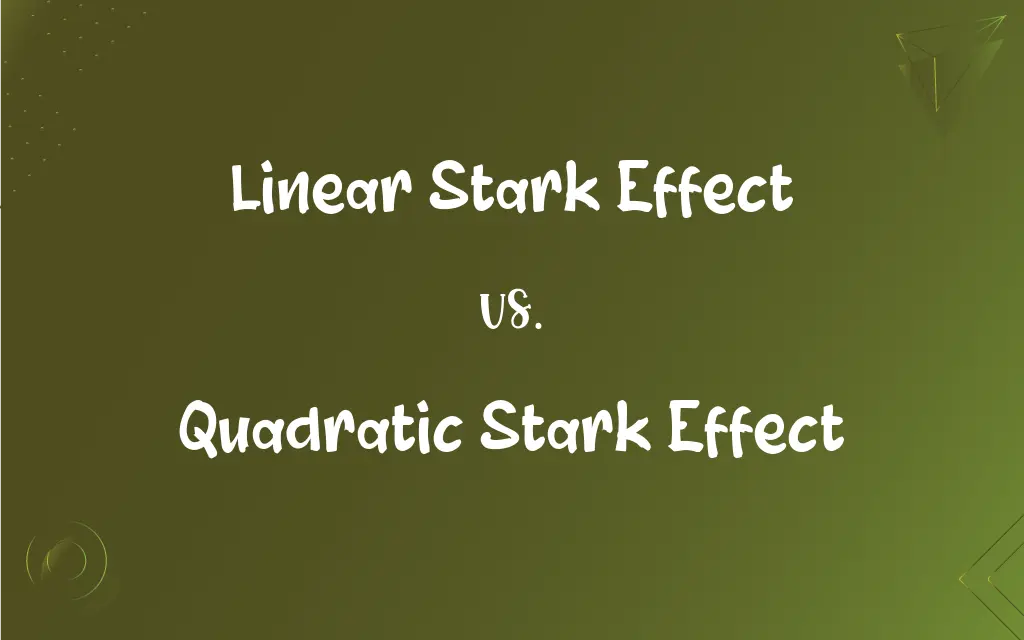Linear Stark Effect vs. Quadratic Stark Effect: What's the Difference?
Edited by Aimie Carlson || By Harlon Moss || Published on February 13, 2024
The linear Stark effect occurs in atoms with non-degenerate energy states under an electric field, while the quadratic Stark effect appears in degenerate or near-degenerate states.

Key Differences
The linear Stark effect results in energy level shifts linearly proportional to the applied electric field in non-degenerate atomic states. Conversely, the quadratic Stark effect causes energy shifts that are proportional to the square of the electric field, occurring in degenerate or near-degenerate states.
In the linear Stark effect, observable in certain atoms and molecules, the energy shift is directly related to the field's strength. The quadratic Stark effect, however, often requires higher field strengths to become significant due to its quadratic nature.
The linear Stark effect can lead to the splitting of spectral lines, a phenomenon easily detectable in experiments. In contrast, the quadratic Stark effect typically results in broader and more complex spectral changes.
The linear Stark effect is observed in atoms like hydrogen, where energy levels are non-degenerate. The quadratic effect is more common in atoms with degenerate energy levels, where the linear effect is absent.
The linear Stark effect is significant in understanding atomic and molecular structures under electric fields. The quadratic Stark effect plays a crucial role in fields like quantum mechanics and electro-optics.
ADVERTISEMENT
Comparison Chart
Energy State Dependence
Occurs in non-degenerate states
Occurs in degenerate or near-degenerate states
Proportionality to Field
Linearly proportional
Proportional to the square of the field
Spectral Line Changes
Causes splitting of lines
Results in broader, complex changes
Common Observability
In certain atoms like hydrogen
In atoms with degenerate energy levels
Application
Useful in studying atomic structures
Important in quantum mechanics, electro-optics
ADVERTISEMENT
Linear Stark Effect and Quadratic Stark Effect Definitions
Linear Stark Effect
The linear Stark effect is the proportional shift of energy levels in an electric field.
The linear Stark effect was observed in the hydrogen atom's spectral lines under an electric field.
Quadratic Stark Effect
The quadratic Stark effect involves energy shifts proportional to the electric field's square.
In the quadratic Stark effect, energy level changes were quadratic to the applied field's strength.
Linear Stark Effect
Linear Stark effect leads to the splitting of spectral lines.
Spectral line splitting in the lab was attributed to the linear Stark effect.
Quadratic Stark Effect
The effect results in complex spectral changes.
The complex spectral patterns observed were due to the quadratic Stark effect.
Linear Stark Effect
The effect results in linearly proportional energy shifts.
In the linear Stark effect, the energy level shift increases directly with the electric field strength.
Quadratic Stark Effect
Quadratic Stark effect is more common in higher field strengths.
At higher electric field strengths, the quadratic Stark effect becomes more pronounced.
Linear Stark Effect
It occurs in atoms with non-degenerate energy states.
Non-degenerate energy states in certain molecules exhibit a clear linear Stark effect.
Quadratic Stark Effect
It occurs in atoms with degenerate or near-degenerate states.
Atoms with degenerate energy levels showed a noticeable quadratic Stark effect.
Linear Stark Effect
It's significant in understanding atomic structures in electric fields.
The linear Stark effect aids in analyzing how atomic energy levels are altered by electric fields.
Quadratic Stark Effect
Important in quantum mechanics and electro-optics studies.
Studies in electro-optics often utilize the quadratic Stark effect for material analysis.
FAQs
Which atoms show the linear Stark effect?
Atoms with non-degenerate energy states, like hydrogen.
What is the quadratic Stark effect?
Energy shifts in degenerate states, proportional to the square of the electric field.
Can the linear Stark effect split spectral lines?
Yes, it can lead to splitting of spectral lines.
What is the linear Stark effect?
Energy level shifts in atoms under an electric field, proportional to the field.
What role does the linear Stark effect play in physics?
It's significant in studying atomic and molecular structures in electric fields.
In what conditions is the quadratic Stark effect observed?
In atoms with degenerate or near-degenerate energy states.
How does the electric field affect the linear Stark effect?
The effect increases linearly with the field's strength.
Is the quadratic Stark effect linear or non-linear?
It's non-linear, with shifts proportional to the field's square.
What type of spectral changes does the quadratic Stark effect cause?
It causes broader and more complex spectral changes.
Are both effects observable in the same atoms?
No, they are typically observable in different types of atoms.
How does the quadratic Stark effect contribute to scientific research?
It's important in quantum mechanics and electro-optics.
Does the linear Stark effect require high electric fields?
Not necessarily, it can be observed at relatively lower fields.
Can the linear Stark effect be used to measure electric fields?
Yes, by analyzing the energy shifts in spectral lines.
What applications does the linear Stark effect have?
It's used in spectroscopy and understanding atomic interactions.
How does temperature affect the quadratic Stark effect?
Higher temperatures can influence the effect's observability.
Do both effects depend on the strength of the electric field?
Yes, but in different ways – linearly and quadratically.
Can the linear Stark effect be observed in all atoms?
No, only in those with non-degenerate energy states.
Does the quadratic Stark effect have practical applications?
Yes, in designing electro-optic devices and quantum computing components.
Are these effects only theoretical concepts?
No, they have practical implications and are observable under laboratory conditions.
Is the quadratic Stark effect relevant in material science?
Yes, especially in studying electro-optic materials.
About Author
Written by
Harlon MossHarlon is a seasoned quality moderator and accomplished content writer for Difference Wiki. An alumnus of the prestigious University of California, he earned his degree in Computer Science. Leveraging his academic background, Harlon brings a meticulous and informed perspective to his work, ensuring content accuracy and excellence.
Edited by
Aimie CarlsonAimie Carlson, holding a master's degree in English literature, is a fervent English language enthusiast. She lends her writing talents to Difference Wiki, a prominent website that specializes in comparisons, offering readers insightful analyses that both captivate and inform.
































































